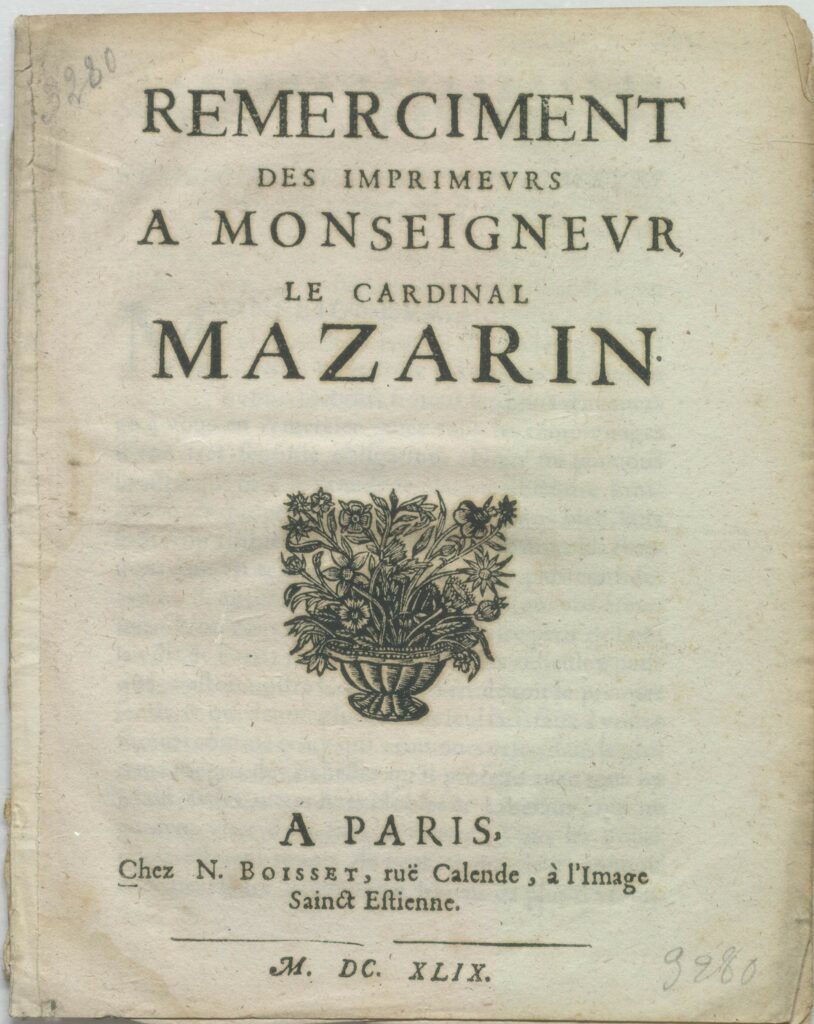Glossary
Libel/pasquil

Other languages
- Dutch: libel, paskwil, steekschrift, schotschrift
- French: libelle, pasquinade, pasquil
- German: Schmähschrift, Pasquill
- Italian: libello famoso, pasquinata
- Polish: paszkwil
- Spanish: libelo, pasquín
Material form
Printed book, Single-sheet printSubject
News and current affairsDescription
Libels and pasquils were types of pamphlets, (often short) polemical writings with a satirical or outright biting tone. The term libel derived from Latin, with libellus being the diminutive form of liber (book). From the 14th century onwards the libel in English indeed referred to a small book. The term pasquil derived from the practice in early modern Rome to stick libellous verses concerning officials to the statue of Pasquino.
The distinction between libels and pasquils is not clear-cut. Satire is a prominent element in both, and both are often directed against public figures or groups, especially those in power. In some languages or contexts the terms are used as synonyms, while sometimes the libel is associated more with defamation and the pasquil with ridicule, or the pasquil is considered a subtype of the libel. In French, libels tend to be associated more with political attacks and pasquils with satires of a broader spectrum of social trends and behaviour of individuals or groups.
By the 17th century, libels and pasquils appeared in various countries not only as pamphlets but also in the form of a broadside. In France, polemic broadsides had already become more socially acceptable during the 16th century and were widely spread later on in the forms of, for example, ballads, sonnets, and mock elegies and epitaphs. Memoires were specifically intended to defame recently deceased public figures. A specific yet large group of libels in France were the Mazarinades, published during the civil wars known as the Fronde (1648 to 1653) and directed against Cardinal Mazarin, then Chief Minister of France. Some 5,000 of these are known. Related to pasquils were the 19th-century Physiologies, satirical stereotypes of social groups or occupations. They were sold as cheap booklets with text and satirical images, while they also appeared as a section in popular newspapers and periodicals.
Related terms
pamphlet, pasquinade, broadside, ballad, lampoon
Sources
O. Bauer, Pasquille in den Fuggerzeitungen. Spott- und Schmähgedichte zwischen Polemik und Kritik (1568–1605) (Vienna: Böhlau/Munich: Oldenbourg, 2008).
A. Bellany, ‘Libel’, in: J. Raymond (ed.), The Oxford History of Popular Print Culture, Vol. 1 (Oxford: Oxford University Press, 2011), 141-163.
H. Carrier, La presse de la Fronde (1648–1653): Les Mazarinades, la conquête de l’opinion (Geneva: Librairie Droz, 1991).
P. Croft, ‘Libels, Popular Literacy and Public Opinion in Early Modern England’, in: Historical Research 68:167 (1995), 266-285.
C. Damianaki and A. Romano (eds.), Pasquin, Lord of Satire, and his Disciples in 16th-Century Struggles for Religious and Political Reform: International Colloquium, London, The Warburg Institute, 14-15 febbraio 2013 (London: The Warburg Institute/Rome: Edizioni di storia e letteratura, 2014).
C. Damianaki, P. Procaccioli, A. Romano (eds.), Ex marmore: pasquini, pasquinisti, pasquinate nell’Europa moderna: atti del Colloquio internazionale Lecce-Otranto, 17-19 novembre 2005 (Manziana: Vecchiarelli, 2006).
R. Darnton, ‘An Early Information Society: News and the Media in Eighteenth-Century Paris’, American Historical Review 105 (2000), 1-35.
T. Debaggi, A coups de libelles. Une culture politique au temps des guerres de Religion (1562-1598) (Geneva: Droz, 2012).
C. Dingemanse, Rap van tong, scherp van pen; literaire discussiecultuur in de Nederlandse praatjespamfletten (circa 1600-1750) (Hilversum: Verloren, 2008).
P. Fumerton and A. Guerrini, ‘Introduction: Straws in the Wind’, in: P. Fumerton, A. Guerrini, K. McAbee (eds.), Ballads and Broadsides in Britain, 1500-1800 (Farnham: Ashgate, 2010), 1-9.
R. Jagersma, Pamflethandel: productie, distributie en consumptie van pamfletten in de Nederlandse Republiek rond 1700, dissertation University of Amsterdam, 2022.
C. Kuhn, ‘Ballads, Libels, and Songs’, in: A. Classen (ed.), The Handbook of Medieval Studies. Terms – Methods – Trends, vol. 2 (Berlin/New York: De Gruyter, 2010).
A. Lhéritier (ed.), Les Physiologies. Catalogue des collections de la Bibliothèque Nationale (Paris: Université de Paris, Institut français de Presse, 1958).
O. Niccoli, Rinascimento anticlericale. Infamia, propaganda e satira in Italia tra Quattro e Cinquecento (Rome-Bari: Laterza, 2005).
G. Schmidt, Libelli Famosi. Zur Bedeutung der Schmähschriften, Scheltbriefe, Schandgemälde und Pasquille in der deutschen Rechtsgeschichte, dissertation University of Cologne, 1985.

